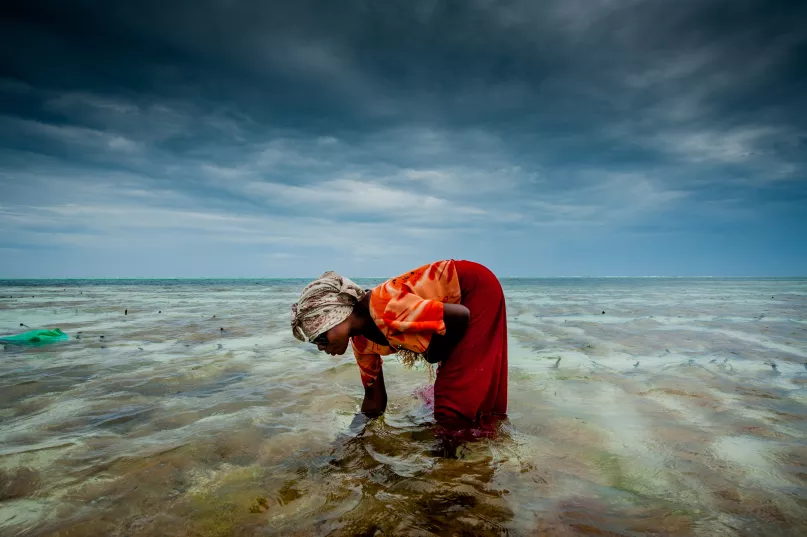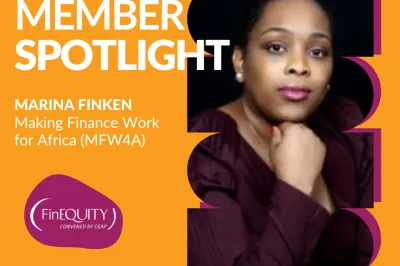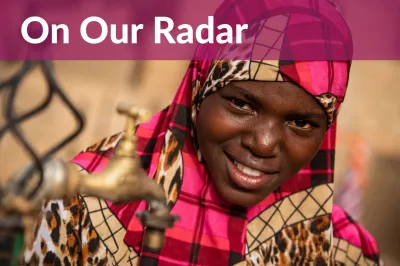Women and Climate Hypotheses and Assumptions

In early 2022, CGAP’s Women in Rural Agricultural Livelihoods (WIRAL) team worked with Dalberg advisors and Agrofin to try and explore the role financial services might play in helping women mitigate and adapt to climatic shocks. We have pulled out seven hypotheses on the nexus between gender, financial inclusion and climate change. These are not exhaustive, and we do not hold them to be definitively true – there might be variation from region to region. Each hypothesis is supported by several assumptions.
Hypotheses and Assumptions
Women depend more on natural resources as they are disproportionately responsible for securing food, water, and fuel.
- In Kenya, South Sudan Ethiopia and Somalia, young women and girls spend up to eight hours a day fetching around 20 liters of water due to the drought. (Seven Weeks For Water 2017, Week 2: "Feminization Of Water Poverty In Africa")
Climate changes can increase social and community stressors, putting women at greater risk of gender-based violence.
- In Chad, due to drought women and girls are forced to walk long distances to obtain water which increases their exposure to sexual harassment and assault and due to male out-migration, women left behind to provide for their families are exposed to sexual violence and exploitation (Climate Change And Gender-Based Violence: What Are The Links?)
Climate shocks increase the likelihood of population displacement.
Environmental changes create greater mobility and time challenges for women.
- In Bangladesh, travel is difficult for women during the monsoon season due to social norms that prohibit them from entering crowded buses. (Understanding Gender Dimensions Of Agriculture And Climate Change In Smallholder Farming Communities)
Women's labor increases due to limited access to natural resources (e.g., water access requires further travel, and this takes more time).
- In Kenya’s Northern region, due to drought, women spent much of their time looking for water, walking long distances to reach boreholes where they queue at water kiosks, competing for water with the large numbers of livestock. (Cyclical Drought In Northern Kenya Takes Toll On Women And Girls)
Socio-cultural norms and laws and regulations can often constrain women’s ability to hold immovable assets.
- In Uganda, since assets conducive to trading make up a larger share of women’s wealth, women’s assets decrease when a household is affected by drought while husband’s assets remain unchanged as women’s wealth is sold to cope. (Gender Dimensions Of Disaster Risk And Resilience)
- See also the Global Gender Gap Report 2021: women experience limited rights in inheriting property and accessing and using land and non-land assets.
Climate change may limit women’s ability to move freely (access to school, training, and other educational facilities).
- In Botswana, a study on droughts and the vulnerability of children and young people found that 70% of children taken out of school were girls, and over 50% of girls reported an increase in traveling further to collect resources for their household (Vulnerability Of Children And Youths In Drought Disasters: A Case Of Botswana)
Climate changes can increase social and community stressors, putting women at greater risk of gender-based violence.
- In Tanzania, droughts lead to an increase in intimate partner violence where females are less empowered. (Gender Equality, Environment & Climate Change)
As male family members migrate for economic opportunities, women’s responsibilities increase at home.
- In Bangladesh, women shoulder unpaid regular and time-consuming domestic tasks, including food preparation, collecting fuel and water, and caring for dependents with increasing male outmigration, women must also manage the farm leaving them time poorer. (Climate Change And Time Poverty Trap Women In A Vicious Cycle)
Land ownership is typically held by men and laws around land ownership/ inheritance often discriminate against women.
- In Kenya, over 65% of land is governed by customary laws that discriminate against women, limiting their land and property rights which means they have no right to own, use as collateral or sell the output without consent from the men. (Women Grow 70% Of Africa's Food But Have Few Rights Over The Land They Tend)
Women often lack the financial resources to purchase inputs (directly or on credit) or their own equipment.
- In Uganda, a study found out that nearly all female-headed households in the study reported a desire to expand agricultural activities but lacked the money to purchase items including inputs such as seeds, fertilizer and pesticides ("I Sell My Labor Now": Gender And Livelihood Diversification In Uganda)
Women are less likely to own mobile phones.
- In Kenya, women in dryland communities have uneven access to climate change responses and disaster risk reduction measures. Women have limited access to mobile phones which are also essential for livestock trading. (Ecosystem Based Adaptation In Kenya’s Arid And Semiarid Rangelands)
- In South Asia, for example, women are 18 percentage points less likely than men to have a mobile phone. In Sub-Saharan Africa, 86% of men have a mobile phone, compared with 77% of women. (Global Findex Database 2021)
- See also the GSMA Mobile Gender Gap Report 2022
Women have less trust in formal services/ financial institutions.
- In Bangladesh, women’s uptake of weather index insurance is limited due to a lack of trust and information from FSPs and low financial literacy. (The Influence Of Gender And Product Design On Farmers’ Preferences For Weather-Indexed Crop Insurance)
Informal financial solutions can be vulnerable to climate change because they may rely on networks of solidarity among close populations who will likely be affected simultaneously by the effects of a climate shock; (e.g., savings groups).
- In Fiji, women are more likely to ask their friends and family for assistance as a coping mechanism due to limited access to formal financial services. These sources are however unreliable as they are also likely to be affected by the same climatic shock. (5 Facts On Gender Equality And Access To Disaster Risk Finance In Fiji)
The likelihood of co-variant shocks will increase with climate stressors.
Women are less likely to have access to and knowledge of climate-resilient inputs.
- In Kenya, there is evidence showing much lower adoption rates of improved seeds and fertilizers for female-headed households than for male-headed households. These differences are partly explained by lower education levels (Gender And Agriculture: Inefficiencies, Segregation, And Low Productivity Trap)
Women have lower access to training (e.g., extension services) and information.
- In some parts of rural Tanzania and Burkina Faso, women are often limited from participating in trainings and meetings where climate-based advisories are discussed due to norms that associate public meeting participation with men and restrict cross-gender interaction in public spaces. (Gender-responsive rural climate services: a review of the literature)
Women are less likely to take up ag insurance and climate-smart agricultural techniques.
- In Bangladesh, women cannot own nor access agricultural machinery due to negative socio-cultural perceptions. It is perceived as inappropriate and socially unacceptable for women to operate agricultural machinery. (Innovative Approaches To Including Gender Within Agricultural Mechanization)
- In Ghana, female farmers are less likely to use weather-index insurance than men, linked in part to their higher illiteracy and lower financial literacy. (Agricultural Insurance Access And Acceptability: Examining The Case Of Smallholder Farmers In Ghana)
Women have lower networks for accessing accurate price information.
- In Kenya, women in dryland communities have limited access to markets for animals and products due to a relative lack of contacts and information. (Ecosystem Based Adaptation In Kenya’s Arid And Semiarid Rangelands)
Women have lower visibility of market information and price volatility which are heightened by climate events (e.g., through smaller networks), and a lesser ability to seize these opportunities.
- In Burkina Faso, women are restricted in responding to market volatility during climate change as although women take care of the livestock, animals (except farmyard birds) belong to the men who dictate when to sell and the price to sell the animals. (Climate Change And Women Farmers In Burkina Faso: Impact And Adaptation Policies And Practices)
Women are less likely to appear on agricultural extension lists (a maize-specific, government-operated education service, for example).
- In India, women have limited access to weather-based agro-advisories as farmers’ group requirements disadvantage women. Participation in farmers’ clubs facilitates enhanced knowledge and awareness of agro-meteorological advisory services; however, annual membership fees can be costly for resource-poor farmers, including women, thus limiting their opportunity to participate. (Assessment of India’s Integrated Agrometeorological Advisory Service program from a farmer perspective)
Time and mobility constraints limit women’s ability to travel to physical markets.
- In Ethiopia, female-headed households that engage in petty trade are unable to sustain their businesses during climatic emergencies/disasters because of their increased responsibilities for managing their households after climate-related shocks. (Rapid Gender Analysis: Research Report)
Women have lower digital literacy, making them less able to access, and less aware of more sophisticated digital markets (e.g., on smartphones).
- In Kenya, women farmers’ engagement is easier with simpler channels (e.g., SMS and IVR calls). It is hard for women to navigate more complex platform components (e.g., USSD-based services and applications). This results in women farmers’ requiring more guidance to navigate more complex digital platforms. (Gender Impact Study)
Digital marketplaces and products are less suited/ hold less relevance for low-income women.
- In Uganda, many women cannot afford the cost of purchasing a mobile phone which requires full payment of the cost of the phone and frequent airtime top-ups which may be more than women can afford. In addition, due to power/electricity limitations, women cannot charge cell phones. This means that even when they access them, they cannot use them. (Gender Mainstreaming In Digital Agriculture)
Access to appropriately designed and delivered financial services, especially digital, can enable women to invest in inputs (e.g., seeds/ technology) and other tools, including social assets, that can diversify and strengthen their livelihoods in the face of climate stressors.
- In Kenya, when women-headed households adopted mobile money savings accounts, poverty dropped, and savings rose, which 185,000 women used as a platform for leaving agricultural jobs for more reliable, higher-paying positions in business or retail that have lower exposure to climate risks. (Women’s Digital Financial Inclusion In Africa)
- In Ghana, women use an asset financing plan from PEG Africa to access solar irrigation pumps which leads to increased crop yields and higher incomes as a result of time and labor savings. (Savings At The Pump: Financing Solar Irrigation To Support Rural Women)
- In Nigeria, 20,000 women farmers use HerVest’s savings platform. Alongside agricultural best practices, it also links women farmers to credit, quality seeds and fertilizer, information, and premium markets, through a blended finance model. (HerVest)


